Halfway around the world from the US mainland, between Singapore, Indonesia, and Malaysia, runs the 550-mile-long Strait of Malacca, a route traversed by tens of thousands of merchant and warships sailing between the Pacific and Indian Oceans. At its eastern terminus, the strait opens into the South China Sea.
Linked together, they form a choke point extraordinaire that exists in the shadow of armed pirates, stateless terrorists, and national armed forces. If the world were to lose access for an extended period, the consequences for the industrialized world, including the United States, would be grave.
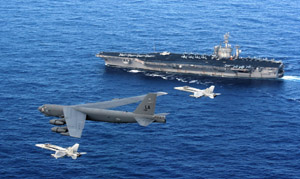 |
USS Nimitz and her crew get a close-up view of a heavy B-52 bomber flying out of Andersen AFB, Guam. |
The Pacific passageway is critical today for two reasons:
-
The lane has become vital to the maintenance of world commerce. Through this constricted oceanic area passes some 30 percent of the planet’s trade. Supertankers traversing the waterway bring in 80 percent of the oil needed to fuel the economies of Japan and China. More ships pass through it than through the Panama and Suez Canals combined. Blockage would be catastrophic. Use of alternative routes would at least triple and possibly quintuple sailing times. Insurance costs would soar. Blows from increased costs and disruptions would damage the US economy.
Fereidun Fesharaki, an authority on the international oil trade at the East-West Center, a think tank in Honolulu, said: “If the sea-lanes through the Straits of Malacca and the South China Sea were blocked, there would be disastrous consequences for the region and indirectly for the US. Indeed, such closure would not be tolerable and they would have to be opened by force.”
Moreover, China claims that large parts of the South China Sea are internal waters, which puts Beijing into possible conflict with the Southeast Asian nations whose shores are washed by the sea. They and the US and other Asian nations dispute the Chinese claim. China is believed to be building a naval base on the island of Hainan, in the northern reaches of the South China Sea.
At the Shangri-la Dialogue in Singapore, Lt. Gen. Ma Xiaotian of the People’s Liberation Army was asked what China could contribute to protect the sea-lanes in that sea and the Strait of Malacca. Ma said: “We have noticed in recent years that all regions in Malacca, coastal Bangladesh, coastal Yemen by the Red Sea, and coastal Somali of East Africa have seen rampant pirate activities which threaten seaborne trade of the countries worldwide.” He continued: “We advocate for mainly relying on the effort of all coastal countries to combat piracy, the international community to observe charter of the United Nations, to observe the international Law of the Sea. Coastal countries should all play the leading role on maritime security against pirate activities. For example, based on this spirit we recently formed an alliance with coastal countries to carry out sea patrol in common waters.”
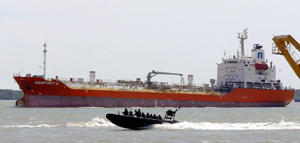 |
Malaysian maritime police buzz past a cargo ship in a show of force demonstration. Pirates have attacked Japanese-owned ships in Malaysian territorial waters. |
Major Oil Route
Adm. Timothy J. Keating, chief of US Pacific Command, was in Indonesia recently to encourage cooperation among Southeast Asians on security in the strait and the South China Sea. Keating urged Indonesia, Malaysia, Singapore, Thailand, and other nations to share intelligence, so that the 50,000 to 70,000 ships (depending on whether coastal ships are included) passing though the sea-lanes each year are safe from pirates and terrorists.
The importance of the strait was underscored by the release last October of the US Navy’s new maritime strategy.
It sets the main concentration for US naval operations in the western Pacific and Indian Oceans. “This combat power can be selectively and rapidly repositioned to meet contingencies that may arise elsewhere,” said the paper. Moving ships between the two oceans expeditiously means transiting the South China Sea and the Strait of Malacca unhindered.
Over the last two decades, as the economies of Asia have leaped forward, their dependence on Middle Eastern oil has gone up. Oil imports to fuel the economies of China, Japan, South Korea, and Taiwan flow through the strait from the Persian Gulf in tankers at a rate of 15 million barrels a day. (In contrast, 4.5 million barrels a day move from the Gulf to Europe through the Suez Canal.)
A disruption would have an immediate effect on those economies, soon to be followed by a devastating effect on the US economy. In 2007, total trade between the US and the four leading Asian economies totaled $742 billion—more than half with China.
Southeast Asian intelligence officers said they have been watching closely—even desperately—for evidence that terrorists are plotting to scuttle supertankers in the Straits of Malacca, Sunda, and Lombok, thus closing the South China Sea to shipping. PACOM officers said governments of the littoral states have trained anti-scuttling forces to react quickly in an effort to prevent that blockage.
Keating, in testimony before Congress in March, agreed on the potential threat from terrorists. “It’s our No. 1 challenge,” he said. “I am more concerned with that than I am with, let’s say, North Korea or the People’s Republic of China.” He was upbeat, though, adding, “The progress we are making, I think, is significant. … We are undertaking as broad an effort as I think we can.”
Ian Storey, a scholar at the Institute of Southeast Asian Studies in Singapore, calls the South China Sea policy “China’s Malacca Dilemma.”
On one hand, Beijing claims the waters from the island of Hainan south to the Indonesian island of Natuna as an internal sea, and has suggested that the United States withdraw from the region. A Chinese admiral suggested that the US and China split the Pacific, with China controlling the western half and the US moving to the east. Keating immediately stated explicitly that the US was in Asia to stay. On the other hand, China’s Navy, while modernizing, is still not strong enough to enforce its claim to the South China Sea and to ensure that the strait remains open for the ships plying the China trade and bringing in the bulk of the nation’s oil imports.
“At present, China lacks the naval power necessary to protect its sea-lanes,” Storey wrote. “Beijing fears that during a national security crisis ships carrying energy resources could be interdicted by hostile naval forces. Any disruption to the free flow of energy resources into China could derail the economic growth on which the Chinese government depends to shore up its legitimacy and pursue its great power ambitions.”
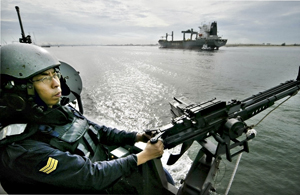 |
A Singaporean sailor keeps watch with a machine gun during a patrol of the waters off of that Asian city-state. |
American Pretext
Thus, China has “a vested interest in the elimination of transnational threats in the waterway,” said Storey, “yet Beijing remains uneasy at the prospect of a greater role for external powers in securing the strait.”
Some Chinese analysts have accused Washington and Tokyo of “using the threat of terrorism” as “a pretext to expand their naval presence in and around the strait.” The Chinese have watched with concern as India has enhanced its presence in the area, especially the modernization of military facilities on the Andaman and Nicobar Islands at the strait’s northwest terminus.
Some in the Chinese commentariat have demonstrated worries that have “bordered on the paranoid,” Storey said. One Chinese newspaper, he observed, recently condemned US Indonesia military cooperation as “targeting China” and aiming at “controlling China’s avenue of approach to the Pacific.”
US strategy is to rely on Southeast Asian nations to take the lead in protecting the waterways. The supporting role of the US ranges from providing equipment and training, combined exercises, bilateral exchanges, ship visits, multilateral conferences, and planning sessions, to medical and humanitarian assistance.
US concerns about the strait and South China Sea are relatively new. A dozen years ago, several Pacific Command officers came together to discuss this sea-lane. When asked how many ships passed through those waters, one said: “We don’t know. Ask Lloyd’s of London, they keep track of those things.”
American interest in the strait, however, was revived four years ago by Adm. Thomas B. Fargo, then PACOM commander. In an address in Singapore to defense ministers and senior military officers from Asia, Fargo proposed a Regional Maritime Security Initiative to protect the sea-lanes from pirates and terrorists.
At first, Fargo’s proposal was misunderstood as suggesting that the US secure the passageways, including posting marines on ships in transit. That caused an uproar among Southeast Asian leaders who saw the security initiative as an encroachment on their sovereignty. They quickly asserted that they would take responsibility for maritime security, which was what Fargo intended.
Adm. William J. Fallon, Fargo’s successor, dropped into the town of Medan not far from the Malacca Strait in Indonesia in February 2006 to discuss the security of the vital waterway. In a meeting with Indonesian naval and police officers, an Indonesian officer told him somewhat diffidently, “Admiral, we really don’t know why you are here. This is our problem and, with our neighbors in Singapore and Malaysia, we can take care of it.”
By the tone of his voice and the look on his face, one could see that Fallon was clearly pleased. “It’s your neighborhood,” he replied, “and you should do it yourselves. If we can help, please let me know.”
The concept appears to have caught on. The Defense Minister of Malaysia, Mohamed Najib Tun Abd Razak, outlined in a speech a year ago the evolution of threats. Before 9/11, he said, security focused on piracy, illegal fishing, and smuggling.
After the terrorist assaults, he said, “the debate has shifted to the potential threat of seaborne terrorism and the risk of terrorist attack on ships transiting along the 885-kilometer [550-mile] waterway. The maritime community also started to link the possibility of a nexus between piracy and terrorism and how piratical activities might become tools of terrorists. Some even raised the possibility of terrorists hijacking tankers and damaging major port facilities.”
Singapore’s Defense Minister, Teo Chee Hean, last year spoke at the Changi Naval Base at the commissioning of the frigate Formidable, first in a class of six ships designed to patrol the Malacca Strait and waters around Singapore. Three more were commissioned in February and all are scheduled to be in service in 2009. Changi is also the site of a pier built by Singapore to service US aircraft carriers.
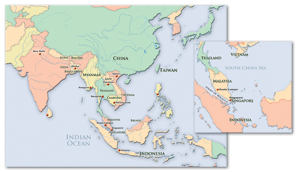 |
The Strait of Malacca touches the interests of many nations. |
Air Engagement
The Air Force is heavily engaged. A squadron of Singaporean F-16s assigned to Luke AFB, Ariz., is used by USAF to train pilots for missions over the South China Sea.
The 425th Fighter Squadron also schools weapon systems officers to operate sensors in the backseat of F-16Ds. About 30 percent of the squadron’s sorties are after dark, with pilots learning to use night vision goggles and practicing low-altitude navigation and infrared targeting. Maintenance crews are included in the training.
There is a constant US airpower presence in Southeast Asia. In February, USAF and Navy aircraft deployed to the Singapore Air Show. For an exercise called Commando Sling, F-16s from the 51st Fighter Wing at Osan Air Base in South Korea flew to Singapore last October. (A second Commando Sling scheduled for January was canceled because many F-15s were grounded at the time.)
USAF and marine aviators joined pilots from the Royal Thai Air Force and the Singapore Air Force in Cope Tiger, in Thailand in February. In Balikatan, a Tagalog word meaning “shoulder to shoulder,” C-130 and C-17 crews moved equipment, people, and relief supplies through Clark Field in the Philippines in March. Maritime security will be built into Balikatan exercises for at least the next five years.
Less visible were sorties of four B-52 bombers that flew from Guam in four directions to Hawaii, Alaska, Northeast Asia, and Australia to hit targets at the same time.
The US is equipping five to 10 radar sites in each of Indonesia, Malaysia, Thailand, and the Philippines to help track ships. The US feeds intelligence to several nations to nudge them into sharing their own information with neighbors. The first Global Hawk unmanned surveillance plane is scheduled to arrive in Guam, the expanding island base in the central Pacific, in 2009; a key mission will be reconnaissance over the South China Sea.
The oldest combined exercise in Southeast Asia saw the US join Thailand, Singapore, Indonesia, and Japan in the 27th Cobra Gold exercise in May that included drills to maintain superiority in and over the sea-lanes. Mobility aircraft can be used for both military and humanitarian assistance. “They may not get as much attention as the pointy-nosed airplanes,” said one PACAF officer, “but they get the job done moving stuff around.”
Intelligence-surveillance-reconnaissance capabilities are high on the training agenda.
In other training, the 31st Marine Expeditionary Unit did beach landing exercises with Indonesian marines in March. The amphibious ship Essex conducted noncombatant evacuation training at sea in February. Essex would become a safe haven for Americans caught in a natural disaster, war, or civil unrest.
The US underscored its interest by moving the Sealift Logistics Command Far East from Japan to Singapore in 2006. The command operates an average of 50 ships in the Pacific and Indian Oceans, delivering fuel and supplies to US ships, transporting cargo, responding to humanitarian crises, and supporting special operations.
Having the logistics unit in Singapore puts it next to Task Force 73, the command it supports. That task force coordinates Pacific Fleet’s Cooperation Afloat Readiness and Training (CARAT) exercises to prepare US warships to operate with the navies of Southeast Asia.
At the eastern end of the South China Sea, US Special Operations Forces are assisting Filipino troops in fighting Abu Sayyaf terrorists in the southern Philippines. Officers at PACOM said the island chains running through the Sulu and Celebes Seas are “ratlines” along which terrorists move among the Philippines, Malaysia, and Indonesia.
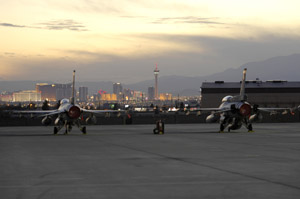 |
Two Singapore F-16s await the “go” for a Jan. 23 mission at Nellis AFB, Nev. Singaporean forces were in Nevada participating in Red Flag, and regularly train with the US on skills needed to defend their local waterways. |
Free-loading
The costs of ensuring safe passage have been controversial. In a statement last year, policy experts from groups representing four of the region’s littoral nations noted, “At present, the costs of ensuring the enhancement of safety of navigation and environmental protection are not borne fairly and equitably amongst littoral states, user states, and other beneficiaries of passage through the straits.”
The Malaysian Defense Minister, Najib, echoed that consternation, asserting that nations whose ships regularly transit the strait had failed to support the costs of maintaining those sea-lanes. “It is regrettable,” he said, “to note that the international users have thus far not matched their usage of the straits with contribution to the costs of maintaining its safety and security.”
He singled out Japan as an exception. Japan, which relies on goods flowing through the strait as much as any nation, has helped “enhance navigational safety through the installation and maintenance of navigational aids as well as pollution preventive measures,” Najib said, and recently “handed over a training ship … to the Malaysian Maritime Enforcement Agency.”
An occasional US show of force reinforces the concept that the US is committed to free navigation in those waters. The carrier Nimitz sailed through the strait last September to join ships from India, Japan, Australia, and Singapore for an exercise named Malabar near the Andaman Islands close to the Indian Ocean end of the Strait of Malacca.
PACOM officers said that getting nations around the South China Sea to work together requires finding ways to overcome issues of sovereignty. Southeast Asian nations once ruled by France, Britain, Portugal, the Netherlands, and the United States jealously guard the independence gained after World War II and are suspicious of hints at encroachment on newly acquired sovereignty.
The principle of “hot pursuit,” for instance, has yet to take hold. For a police vessel to chase a terrorist ship from the territorial waters of one country into the waters of another would violate the sovereignty of the second, and thus would be unacceptable.
American officers encourage multinational cooperation through four steps. First is to get agencies within a nation to work together, a difficult task even in the US. In Indonesia, for example, 13 agencies are engaged in maritime security.
Second is to get a nation to work across the border with its neighbor. Using subdued language can be essential. “Common operating picture,” a phrase Americans use to mean that everyone engaged is seeing the same information at the same time, is shunned as suggesting offensive operations. “Shared situational awareness” is more acceptable.
Third is to persuade those engaged to agree on a process for rapid decisions. In cultures in which decisions are often made by consensus, this takes patient explanation.
Fourth is actual interdiction of a suspected pirate or terrorist by ships and aircraft, and handing information in a timely manner to another nation’s forces. Much has been accomplished through seminars that start out at bilateral senior levels and progress to multilateral gatherings of middle-grade officers.
Richard Halloran, formerly a New York Times foreign correspondent in Asia and military correspondent in Washington, D.C., is a freelance writer based in Honolulu. His most recent article for Air Force Magazine, “Protracted Nuclear War,” appeared in the March issue.